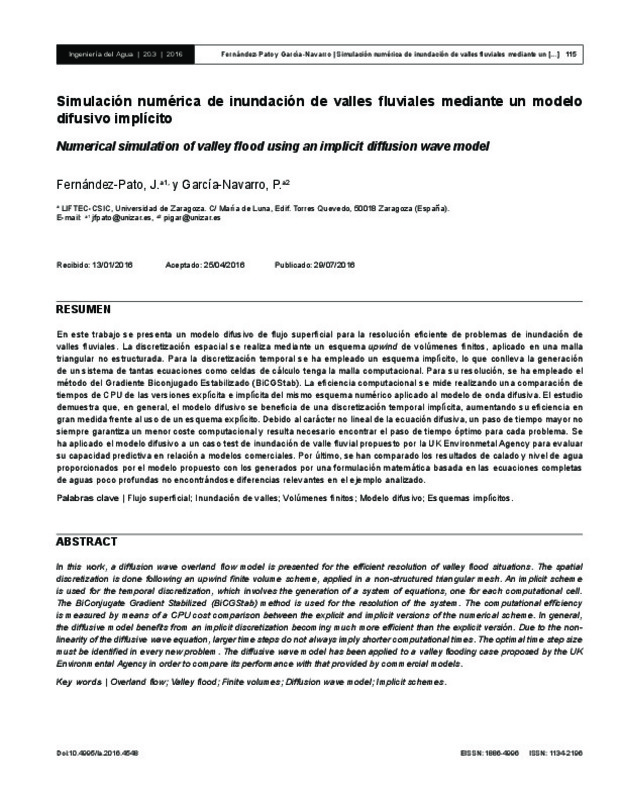Burden, R.L., Faires, J.D. (2010). Numerical analysis. Brooks/Cole, Cengage Learning.
Cea, L., Garrido, M. Puertas, J. (2010). Experimental validation of two-dimensional depth-averaged models for forecasting rainfallrunoff
from precipitation data in urban áreas. Journal of Hydrology, 382(1-4), 88-102. doi:10.1016/j.jhydrol.2009.12.020
[+]
Burden, R.L., Faires, J.D. (2010). Numerical analysis. Brooks/Cole, Cengage Learning.
Cea, L., Garrido, M. Puertas, J. (2010). Experimental validation of two-dimensional depth-averaged models for forecasting rainfallrunoff
from precipitation data in urban áreas. Journal of Hydrology, 382(1-4), 88-102. doi:10.1016/j.jhydrol.2009.12.020
Chen, J., Chen, J., Liao, A., Cao, X., Chen, L., Chen, X., He, C.., Han, G., Peng, S. Lu, M., Zhang, W., Tong, X., Mills, J. (2015). Global land cover mapping at 30 m resolution: A POK-based operational approach. ISPRS Journal of Photogrammetry and Remote Sensing, 103, 7-27. doi:10.1016/j.isprsjprs.2014.09.002
Debella-Gilo, M., Etzelmüller, B. (2009). Spatial prediction of soil classes using digital terrain analysis and multinomial logistic regression modeling integrated in GIS: Examples from Vestfold County, Norway. Catena, 77(1), 8-18. doi:10.1016/j.catena.2008.12.001
Guennebaud, G., Jacob, B. (2010). Eigen v3. http://eigen.tuxfamily.org.
Lal Wasantha, A. (1998). Weighted implicit finite-volume model for overland flow. Journal of Hydraulic Engineering, 124(9), 941-950. doi:10.1061/(ASCE)0733-9429(1998)124:9(941)
López-Barrera, D., García-Navarro, P., Brufau, P. Burguete, J. (2012). Diffusive-wave based hydrologic-hydraulic model with sediment transport I: model development. Journal of Hydrologic Engineering, 17(10), 1093-1104. doi:10.1061/(ASCE)HE.1943-5584.0000552
Maguya, A.S., Junttila, V., Kauranne, T. (2013). Adaptive algorithm for large scale DTM interpolation from LIDAR data for forestry applications in steep forested terrain. ISPRS Journal of Photogrammetry and Remote Sensing, 85, 74-83. doi:10.1016/j.isprsjprs.2013.08.005
Mahmood, K., Yevjevich, V. (1975). Unsteady flows in open channels. Water Resources Publications, Fort Collins, Colorado.
Merwade, V., Cook, A., Coonrod, J. (2008). GIS techniques for creating river terrain models for hydrodynamic and flood inundation mapping. Environmental Modelling & Software, 23(10-11), 1300-1311. doi:10.1016/j.envsoft.2008.03.005
Moussa, R., Bocquillon, C. (2009). On the use of the diffusive wave modelling extreme flood events with overbank flow in floodplain. Journal of Hydrology, 374(1-2), 116-135. doi:10.1016/j.jhydrol.2009.06.006
Mui, A., He, Y, Weng, Q. (2015). An object-based approach to delineate wetlands across landscapes of varied disturbance with high spatial resolution satellite imagery. ISPRS Journal of Photogrammetry and Remote Sensing, 109, 30-46. doi:10.1016/j.isprsjprs.2015.08.005
Murillo, J., García-Navarro, P. (2010). Weak solutions for partial differential equations with source terms: Application to the shallow water equations. Journal of Computational Physics, 229(11), 4327-4368. doi:10.1016/j.jcp.2010.02.016
Neal, J., Villanueva, I., Wright, N. Willis, T. Fewtrell, T., Bates, P. (2012). How much physical complexity is needed to model flood inundation? Hydrological Processes, 26(15), 2264-2282. doi:10.1002/hyp.8339
Néelz, S., Pender, G. (2013). Benchmarking of 2D hydraulic modelling packages. UK Environmental Agency.
Gomez-Pereira, L.M., Wicherson, R.J. (1999). Suitability of laser data for deriving geographical information: A case study in the context of management of fluvial zones. ISPRS Journal of Photogrammetry and Remote Sensing, 54(2-3), 105-114. doi:10.1016/S0924-2716(99)00007-6
Ponce, V.M. (1986). Diffusion wave modeling of catchment dynamics. Journal of Hydraulic Engineering, 112(8), 716-727. doi:10.1061/(ASCE)0733-9429(1986)112:8(716)
Rabus, B., Eineder, M., Roth, A., Bamler, R. (2003). The shuttle radar topography mission - a new class of digital elevation models acquired by spaceborne radar. ISPRS Journal of Photogrammetry and Remote Sensing, 57(4), 241-262. doi:10.1016/S0924-2716(02)00124-7
Saad. Y. (1994). ILUT: A dual threshold incomplete LU factorization. Numerical Linear Algebra with Applications, 1(4), 387-402. doi:10.1002/nla.1680010405
van der Vorst, H.A. (1992). BI-CGSTAB - A fast and smoothly converging variant of BI-CG for the solution of nonsymmetric linear-systems. SIAM Journal of Scientific and Statistical Computing, 13(2), 631-644. doi:10.1137/0913035
Vreugdenhill, C.B. (1994). Numerical Methods for Shallow Water Flow. Kluwer Academic Publishers. doi:10.1007/978-94-015-8354-1
[-]








